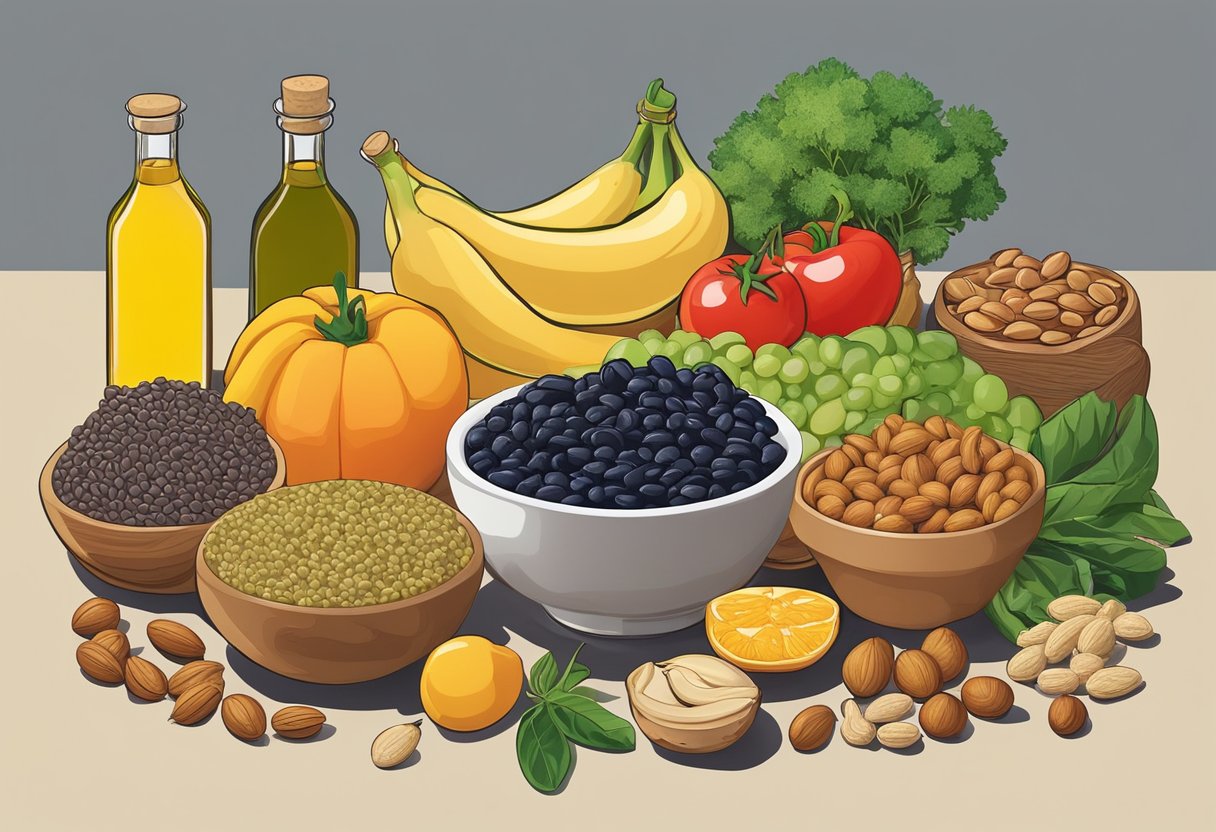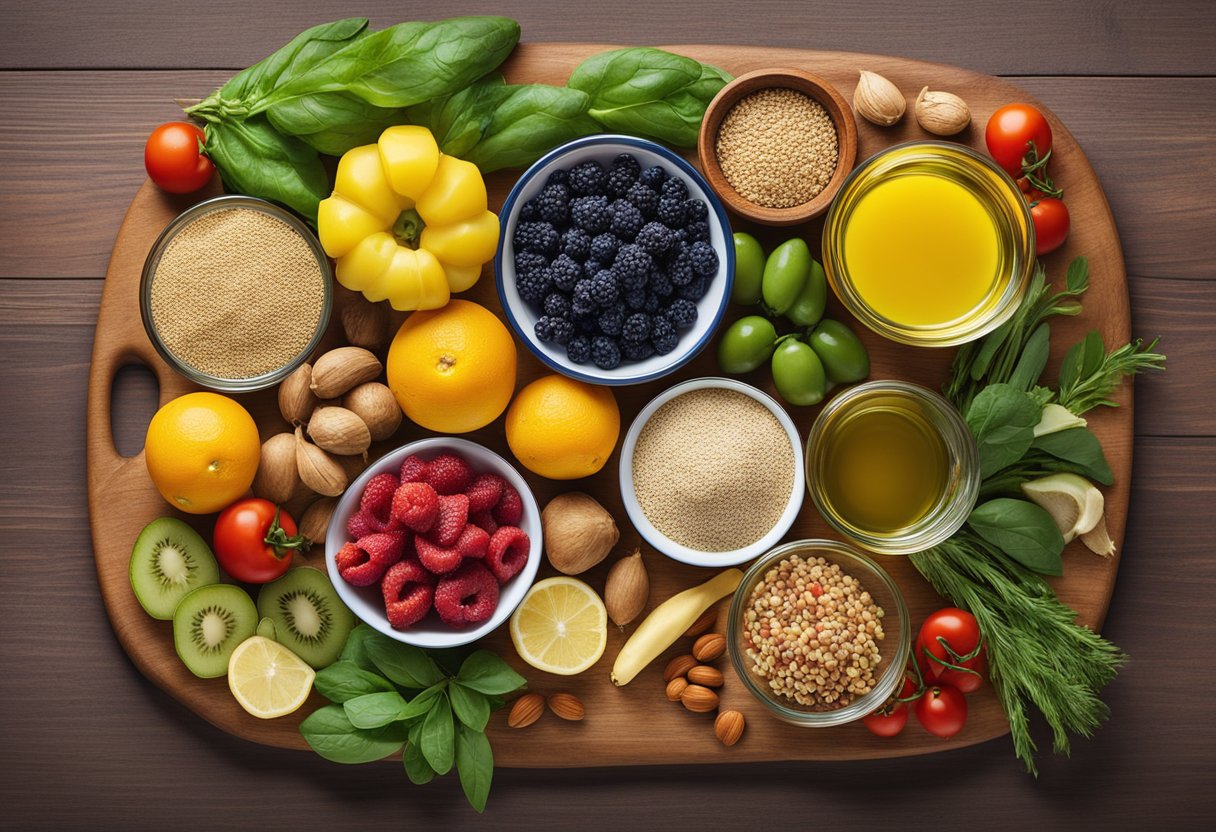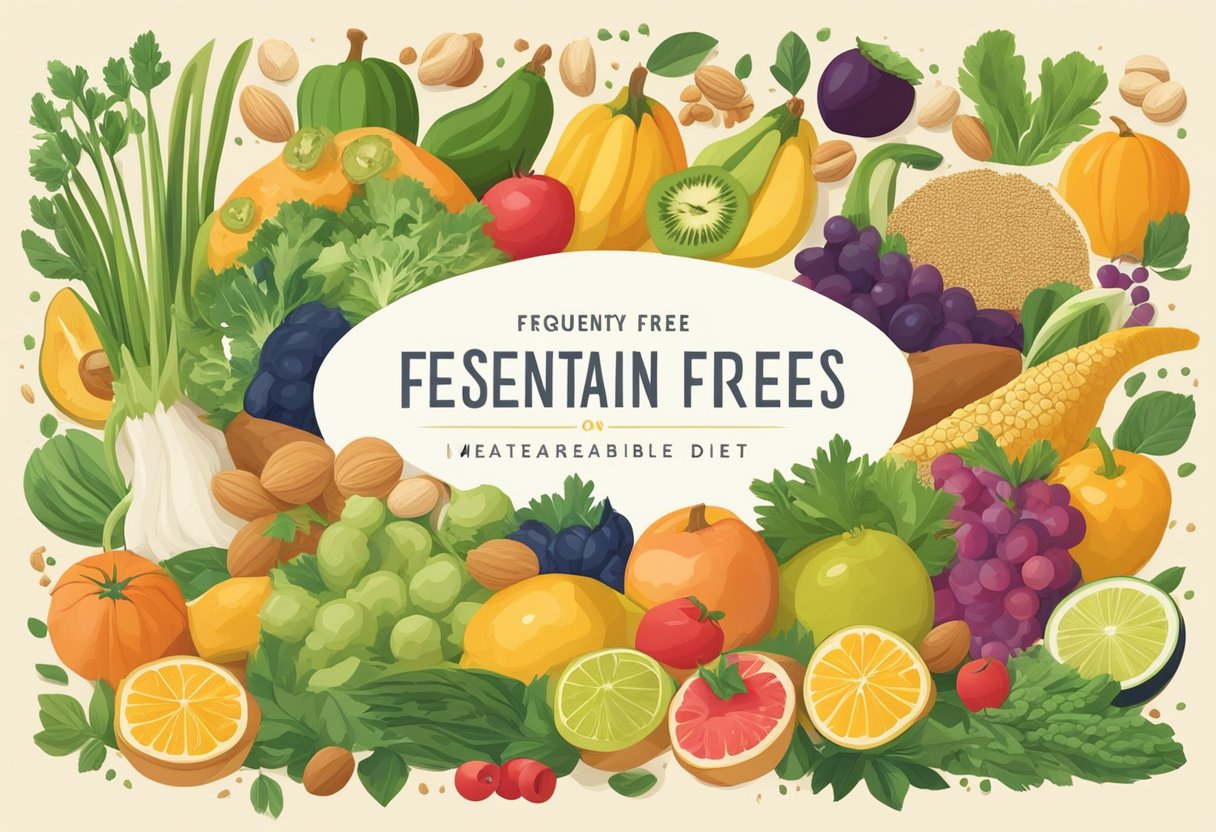The concept of sustainable eating marries well with the principles of the Mediterranean diet when adapted to accommodate a gluten-free lifestyle. This diet focuses on whole foods such as fruits, vegetables, legumes, nuts, seeds, fish, and lean meats, which are naturally gluten-free and form the cornerstone of environmentally sustainable dietary patterns. By choosing local and seasonal produce, adherents can reduce their carbon footprint while enjoying a diverse and nutritious menu. Additionally, incorporating gluten-free whole grains such as quinoa and buckwheat can offer the textural and health benefits that traditional Mediterranean whole grains provide, without the gluten.

Transitioning to a gluten-free Mediterranean diet requires mindful planning to ensure nutritional adequacy and maintain the diet’s inherent health benefits. The absence of gluten-bearing grains necessitates finding alternative sources of certain vitamins and minerals, typically abundant in whole wheat and other gluten-containing grains. Careful substitutions with gluten-free alternatives that have similar nutritional profiles can ensure the diet remains balanced. Furthermore, understanding how to navigate food labels and dining out can empower individuals to make informed decisions that support their dietary needs and preferences.
Key Takeaways
- A gluten-free Mediterranean diet emphasizes naturally gluten-free whole foods and is compatible with sustainable eating practices.
- Nutritional adequacy on this diet is maintained through strategic planning and substituting gluten-containing grains with nutritious gluten-free alternatives.
- Comprehensive knowledge of food labeling and dining options is crucial for adhering to a gluten-free Mediterranean diet while reaping its health benefits.
Table of Contents
Understanding the Basics

Integrating the rich flavors and nutritional benefits of the Mediterranean diet with the health necessities of a gluten-free lifestyle creates a unique fusion that promotes well-being. This section will provide a thorough foundation for understanding and implementing a sustainable gluten-free Mediterranean diet.
Overview of the Mediterranean Diet
The Mediterranean diet is centered around the traditional eating patterns of countries bordering the Mediterranean Sea. It emphasizes a high intake of vegetables, fruits, nuts, seeds, legumes, and whole grains, alongside healthy fats such as olive oil. Moderate amounts of fish and poultry also form integral components of this diet, with red meat and sweets consumed less frequently.
Principles of the Gluten-Free Diet
A gluten-free diet eliminates all forms of gluten, a protein found in wheat, barley, and rye, which can trigger adverse reactions in individuals with celiac disease or gluten sensitivities. The diet includes a variety of gluten-free grains and focuses on whole foods to maintain a balanced intake of essential nutrients.
Health Benefits of Combining Both Diets
Combining both diets can lead to numerous health benefits, including reduced inflammation and a lower risk of heart disease, cancer, Alzheimer’s disease, and other chronic conditions. The fusion diet is replete with antioxidants from fruits and vegetables and provides adequate fiber and protein from gluten-free sources.
Nutritional Considerations and Adjustments
Following this diet requires careful selection of ingredients to ensure that the body’s nutritional needs are met. It’s important to substitute gluten-containing grains with gluten-free alternatives that offer similar levels of fiber, calcium, and other nutrients. Options include quinoa, brown rice, and gluten-free oats.
Potential Challenges and Solutions
One challenge is avoiding cross-contamination with gluten, which can trigger symptoms in sensitive individuals. Implementing strict kitchen practices and identifying genuinely gluten-free products are crucial steps. Another challenge can be finding substitutes for traditional Mediterranean foods like couscous, which typically contain gluten.
Role of Physical Activity
Physical activity is a cornerstone of the traditional Mediterranean lifestyle and should be harmonized with dietary habits. Regular exercise contributes significantly to overall health and can combat chronic diseases alongside a well-planned diet.
Environmental Impact of Diet Choices
Adopting a gluten-free Mediterranean diet can also positively impact the environment. The diet’s reliance on seasonal, locally-sourced fruits and vegetables and fewer animal products decreases the carbon footprint associated with food production and transport. Additionally, it promotes biodiversity and soil health through varied crop rotations and less intensive farming practices.
Dietary Components Explained

The Gluten-free Mediterranean diet merges the heart-healthy aspects of the traditional Mediterranean diet with a gluten-free regimen. It emphasizes natural, minimally processed foods, rich in nutrients necessary for overall health.
Fruits and Vegetables
Fruits and vegetables are the cornerstones, providing an abundance of fiber and antioxidants. One is encouraged to consume a variety of colorful selections, like leafy greens for vitamins and berries for antioxidants. These plant foods are incorporated into daily meals, ensuring essential nutrients and promoting digestive health.
Gluten-Free Whole Grains
Whole grains are integral, but on a gluten-free Mediterranean diet, choices like buckwheat, corn, rice, and quinoa replace traditional wheat-based grains. Brown rice and oats labeled gluten-free are also safe options, delivering essential B vitamins and fiber without gluten.
Proteins: from Sea to Land
Proteins come primarily from fish, which provides omega-3 fatty acids. Other sources include legumes, meat, and poultry, which should be lean and consumed in moderation. Eggs, nuts, and seeds also contribute proteins while offering versatile options for meal planning.
Healthy Fats and Oils
Olive oil is the primary source of healthy fats in the Mediterranean diet. The use of unprocessed fats from nuts and seeds enhances flavor and adds to the nutrient-rich profile of the diet, supporting heart health and providing antioxidants.
Dairy and Alternatives
Dairy products, including yogurt and cheese, should be enjoyed in moderate amounts. When selecting dairy, one opts for low-fat or fat-free varieties to maintain the balance of the diet. Lactose-free and plant-based alternatives like almond or soy milk are suitable substitutions.
Herbs, Spices, and Flavor Enhancers
Rather than relying on salt for flavor, the diet makes use of a plethora of herbs and spices. This not only reduces sodium intake but also infuses dishes with rich flavors and offers health benefits, such as anti-inflammatory properties found in turmeric and cinnamon.
Gluten-Free Mediterranean Diet Planning
When embarking on a gluten-free Mediterranean diet plan, it’s important to include a variety of nutrient-dense foods that align with Mediterranean dietary patterns, while also ensuring that all sources of gluten are eliminated.
Breakfast Options
For breakfast, options like oatmeal made with certified gluten-free oats can be a warm and satisfying choice. Add a mix of nuts and fruits for extra fiber and nutrients. Eggs, scrambled or poached, alongside sautéed vegetables like spinach, can also provide a protein-rich start to the day.
- Certified Gluten-Free Oatmeal:
- Topped with almonds and fresh berries
- Egg Scramble:
- With spinach, tomatoes, and feta cheese
Lunch Ideas
Lunch can include salads made with a base of gluten-free whole grains like quinoa or brown rice. Top it with grilled salmon for omega-3 fats and complete the meal with a variety of colorful vegetables.
- Quinoa Salad:
- Quinoa, cucumbers, tomatoes, olives, and grilled salmon
- Brown Rice Bowl:
- Brown rice, mixed greens, and grilled chicken breast with lemon-herb dressing
Dinner Menu Inspirations
For dinner, focus on vegetables and fish or meat as the main components, accompanied by sides of legumes or gluten-free grains. Meat should be enjoyed in moderation, with an emphasis on poultry or lean cuts.
- Grilled Fish:
- Served with a side of roasted Mediterranean vegetables and lentils
- Chicken Kebabs:
- With bell peppers, onions, and a quinoa tabbouleh
Snacks and Treats
Snacks can be as simple as a handful of nuts and seeds or as indulgent as gluten-free versions of traditional Mediterranean treats. Fruits and vegetables are also perfect for a quick bite.
- Trail Mix:
- Almonds, pumpkin seeds, sunflower seeds, and dried apricots
- Hummus:
- Paired with carrot and cucumber sticks
Beverages Selection
For beverages, emphasis is on staying hydrated with water, while also enjoying tea and the occasional glass of wine within moderation.
- Water:
- Infuse with lemon or cucumber for added flavor
- Green Tea:
Meal Prepping Tips
Meal prepping can save time and ensure adherence to the diet. Cook gluten-free grains in bulk and use a variety of fresh and seasonal vegetables. Prepare proteins at the beginning of the week and portion them out for upcoming meals.
- Cook grains in large batches:
- Quinoa, brown rice, or gluten-free pasta
- Prep vegetables:
- Wash, cut, and store in airtight containers
Sample Gluten-Free Mediterranean Diet Meal Plan
Here’s a concise meal plan to illustrate a day on a gluten-free Mediterranean diet:
- Breakfast: Gluten-free toast with avocado and a side of Greek yogurt
- Lunch: Chickpea salad with olive oil vinaigrette
- Dinner: Baked cod with a side of roasted brussels sprouts and butternut squash
- Snacks: Sliced pear with almond butter; Mixed nuts
- Beverage: Water throughout the day; Green tea with lunch; A glass of red wine with dinner
Each meal balances the need for gluten-free options while adhering to the principles of the Mediterranean diet, offering a diverse range of foods full of flavor, nutrients, and health benefits.
Culinary Adaptations and Substitutions

Adapting the traditional Mediterranean diet to suit a gluten-free lifestyle requires careful consideration of ingredients and preparation methods to maintain both the integrity of the cuisine and adhere to dietary needs.
Modifying Traditional Mediterranean Recipes
The foundation of Mediterranean cuisine lies in its diversity of fresh vegetables, fruits, whole grains, legumes, and healthy fats, like olive oil. To modify traditional Mediterranean recipes for a gluten-free diet, one must focus on utilizing ingredients that inherently do not contain gluten. For instance, dishes that typically include bulgur or couscous can be prepared with gluten-free grains such as quinoa or rice.
- Tabbouleh: Replace bulgur with cooked quinoa.
- Pasta dishes: Use gluten-free pasta made from rice or legume flours.
Gluten-Free Alternatives
When adhering to a gluten-free diet, identifying safe gluten-free alternatives is crucial. Grains like millet, brown rice, and buckwheat are excellent staples. Additionally, nuts and seeds are integral to the diet, both for their nutritional value and as thickeners in place of breadcrumbs or flour. These alternatives not only maintain the nutritional profile but also align with the Mediterranean preference for plant-based ingredients.
- Breadcrumbs: Substitute with ground almonds or flaxseeds.
- Flour for thickening: Use cornstarch or certified gluten-free oat flour.
Decoding Food Labels
Maintaining a gluten-free diet requires diligence in decoding food labels. Cross-contamination can be a significant concern, especially in products that are not certified gluten-free. Individuals must look beyond the ingredient list for disclosures about shared processing facilities. Additionally, it is important to watch out for hidden sources of gluten, like malt syrup or added sugars, that sometimes appear in packaged foods.
- Look for: “Certified gluten-free” label for assurance against cross-contamination.
- Be cautious of: Vague labeling terms such as “natural flavors” or “spices,” which could contain gluten.
In summary, successfully combining Mediterranean flavors with a gluten-free diet is achievable through deliberate ingredient choices and vigilant attention to potential sources of gluten.
Shopping and Dining Out

Embarking on a sustainable eating journey with the gluten-free Mediterranean diet requires mindful shopping and dining choices. Knowing where to find whole foods and how to select gluten-free grains and avoid cross-contamination are key to maintaining this lifestyle.
Navigating Grocery Store Aisles
When perusing the grocery store aisles, individuals should focus on whole foods that are naturally gluten-free, such as fruits, vegetables, nuts, and seeds. Gluten-free grains like quinoa, rice, and certified gluten-free oats can be fantastic staples for various Mediterranean dishes. It’s important to check labels for the certified gluten-free seal to avoid any cross-contamination with gluten-containing products.
Eating Out and Avoiding Gluten
Dining out on the gluten-free Mediterranean diet can be enjoyable with the right precautions. Individuals should seek out restaurants known for their gluten-free options and clearly communicate their dietary restrictions to the staff. To minimize the risk of cross-contamination, they can inquire about the restaurant’s preparation practices and whether they have a dedicated gluten-free cooking area.
Consulting with Nutrition Professionals
For tailored advice on sustaining a gluten-free Mediterranean diet, consulting with a registered dietitian is advisable. These professionals can provide personalized nutritional advice, including how to balance the diet with the right proportions of macronutrients and how to ensure that the diet is nutritionally complete, particularly when it comes to selecting gluten-free alternatives.
Health Management and Diet Monitoring

Managing health on a gluten-free Mediterranean diet involves continual monitoring and education to ensure nutritional needs are met without triggering gluten sensitivities or exacerbating chronic conditions. This approach aids in the prevention and management of health issues including heart disease, type 2 diabetes, and obesity.
Tracking Symptoms and Dietary Impact
Individuals should monitor their symptoms regularly and assess the impact specific foods have on their well-being. A food diary can be an effective tool for identifying potential food triggers and ensuring that their dietary pattern aligns with their health goals. It becomes especially important for those with gluten sensitivities or celiac disease to observe their reactions to gluten-free foods and maintain moderation in their consumption of certain items.
Regular Health Check-ups and Assessments
Health monitoring, such as routine check-ups with healthcare providers, is vital for assessing how well one’s diet supports their overall health. Regular consultations with a registered dietitian can provide tailored advice, ensuring adherence to dietary guidelines and addressing any potential nutrient deficiencies. These professionals can also track clinical parameters, such as blood pressure and weight, to manage chronic diseases effectively.
Coping with Dietary Restrictions
Coping with dietary restrictions requires both practical and emotional well-being strategies. For instance, individuals can explore a variety of gluten-free grains and substitutions within the Mediterranean diet’s framework to maintain diversity in their meals. Additionally, joining support groups can provide emotional support and shared experiences that help manage the limitations imposed by dietary restrictions.
Continuing Education and Resources
Staying informed about the latest research updates and resources available for a gluten-free Mediterranean diet is crucial. Educational materials might include scientific articles, nutritional guides, and recipe books that adhere to the principles of Mediterranean dietary patterns while eliminating gluten. These resources assist individuals in making informed decisions about their health and diet, and underline the importance of evidence-based nutritional practices.
Cultural and Regional Influences

When considering the gluten-free Mediterranean diet, one cannot overlook the profound impact of cultural and regional factors that shape dietary choices. These influences steer both traditional consumption patterns and modern adaptations necessary for health and sustainability.
Mediterranean Culinary Traditions
The Mediterranean diet is rooted in the food traditions of countries like Greece and Italy, where olive oil, seafood, and fresh produce are dietary staples. Traditional dishes from these regions reflect a harmony between taste and nutrition, making the Mediterranean diet renowned for its health benefits. The incorporation of gluten-free grains aligns with the diet’s emphasis on plant-based foods, accommodating those with celiac disease or gluten sensitivity.
Adapting to Local Food Availability
Sustainability within the gluten-free Mediterranean diet is supported by adapting to local food availability. This practice encourages the consumption of seasonal produce from local markets, reducing the carbon footprint while supporting regional economies. Local adaptations may also include substituting traditional gluten-containing grains with local gluten-free options, enhancing dietary variety and fostering innovation in gluten-free Mediterranean cuisine.
Worldwide Trends in Healthy Eating
Global dietary trends increasingly reflect an interest in both nutritional science and sustainability. As individuals seek out diets that support long-term health, the gluten-free Mediterranean diet’s rich array of seafood, olives, and seasonal produce offers a blueprint adopted widely. This expansion beyond the Mediterranean region illustrates a global recognition of the diet’s nutritional value and environmental benefits, with many worldwide incorporating global cuisines into their own unique versions of this time-tested diet.
Frequently Asked Questions

Adopting a sustainable, gluten-free Mediterranean diet involves thoughtful planning and understanding of the nutritious foods involved. This section addresses common inquiries to facilitate a smooth dietary transition.
What are some daily meal plan suggestions for a gluten-free Mediterranean diet?
Individuals may start their day with a breakfast of Greek yogurt and fruit, follow with a quinoa salad for lunch, and enjoy grilled fish with vegetables for dinner. They should include gluten-free grains like quinoa and millet, incorporate healthy fats from nuts and seeds, and focus on plant-based foods.
Could you suggest a variety of gluten-free Mediterranean diet recipes?
For diverse meal options, one may explore dishes such as lemon-herb grilled chicken, stuffed bell peppers with ground turkey and herbs, and roasted vegetable quinoa bowls. Incorporating seafood like pan-seared salmon and preparing bean-based soups can provide both protein and fiber.
What should I include in a shopping list tailored for a gluten-free Mediterranean diet?
A shopping list might feature fresh fruits and vegetables, lean proteins such as chicken and fish, legumes, nuts and seeds, and gluten-free whole grains like brown rice and buckwheat. Don’t forget essential fats, like olive oil and avocados.
Which cookbooks offer the best selection of gluten-free Mediterranean diet recipes?
Several cookbooks that are highly regarded in the gluten-free Mediterranean space include “The Gluten-Free Mediterranean Cookbook” by Tess Challis and “Mediterranean Paleo Cooking” by Caitlin Weeks, which cater to those avoiding gluten while seeking Mediterranean flavors.
What options are available for a gluten-free Mediterranean diet breakfast?
Breakfast options might include shakshuka with gluten-free bread, almond flour pancakes topped with fresh berries, or an omelette with spinach and feta. These dishes emphasize vegetables and proteins, aligning well with Mediterranean diet principles.
How can someone on a dairy-free regimen adapt Mediterranean diet recipes to be gluten-free?
To adapt Mediterranean recipes for a dairy-free and gluten-free diet, one can substitute dairy products with alternatives like almond or coconut-based cheese and yogurt. They should focus on the naturally dairy-free elements of the diet, such as fruits, vegetables, and seafood.



